- Home
- Sustainability
- Environment
- Sustainable Forest Management
- Sustainable Forest Management by the Sumitomo Forestry Group
Sustainable Forest Management by the Sumitomo Forestry Group
Forest Overview of the Sumitomo Forestry Group
-
Forest Managed Area:
Approximately
365,000 ha -
Forest Certified Area:
Approximately
275,000 ha
Forest management, certification, and production forest area in FY2024
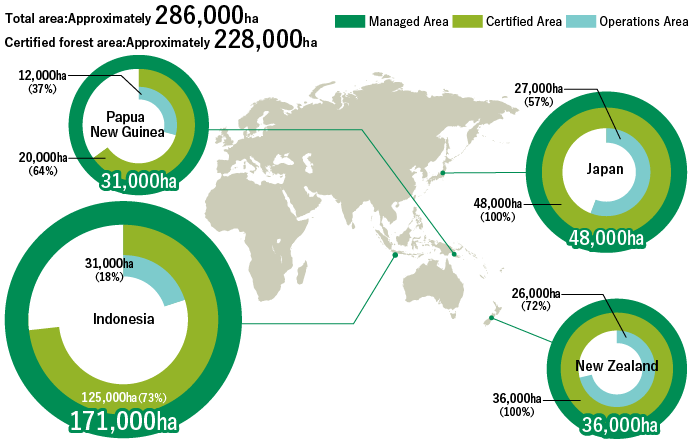
Basic Policy
In addition to supply function of producing wood, forests have diverse public benefits such as water source recharge, prevention of landslides, CO2 absorption and fixation as a countermeasure to global warming, preservation of biodiversity, and recreation.
The Sumitomo Forestry Group's businesses that handle timber resources are closely connected with forests. We advance sustainable forest management both in Japan and overseas to ensure that wood resources will be available in perpetuity while preserving the public benefits of forests. In addition, we are promoting acquisition of forest management certification in Japan and overseas in each business of upstream forest management, midstream timber distribution and manufacturing, and downstream wooden construction.
In our domestic forestry business, we will pursue profitability through wood production in Company-owned forests, while at the same time practicing sustainable forest management that ensures legality and takes biodiversity and local culture into consideration, and obtain and maintain 100%*1 forest certification in forests subject to certification.
As for the overseas forestry acquisition, below are the guiding principles for selection when obtaining new forests areas.
- Forests areas that have good relationships with surrounding villages and local communities.
- Forest areas where HCVA*2, HCSA*3 and FPIC*4 can be implemented, environmental risks can be eliminated, and no environmental problems were identified in the past.
- Forest areas with third-party forest certification (FSC®-FM is preferable and FSC-CW and PEFC certification are acceptable as well).
*1Except for land leased to Kawanokita Development and surrounding forests
*2High Conservation Value Assessment: inspection and assessment to establish conservation policies for areas specified as having high conservation value, such as rare flora and fauna habitat
*3High Carbon Shock Assessment: inspection and assessment to specify and restrict development in areas with high carbon absorption volumes so that the volume of carbon retained by forests does not decline when forest land is converted to other uses
*4Free Prior Informed Consent: Prior sharing of information and consensus formation with indigenous people and others in cases where there is likelihood that operations could impact the lands, territories or resources of indigenous people
- Click here for related information
Forest Management and Wood Usage
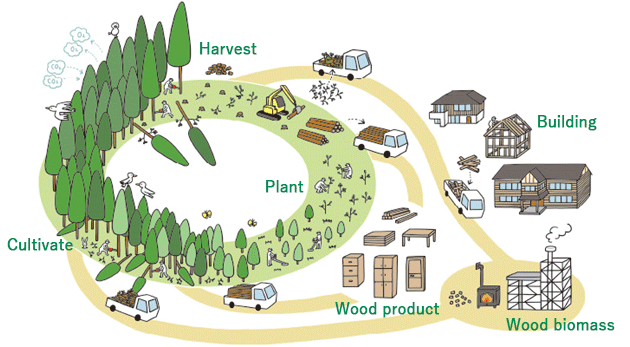
Sustainable Forest Management
Seedling Farming and Cultivation
Securing superior seedlings is a crucial first step toward sustainable forest management. Stable production of superior seedlings enables appropriate forest establishment. Sumitomo Forestry was the first to modernize seedling production. We are contributing to the sustainability of forest resources and active resource production through facility-based nursery seedlings cultivated in under appropriate environmental management. In Japan, in fiscal 2019, we opened our sixth production facility in Minamiaizu Town, Fukushima Prefecture, which is capable of producing 1.9 million seedlings per year and supplying them to our own company-owned forests as well as to national forests and privately-owned forests throughout Japan. Overseas, in Indonesia and Papua New Guinea, we produce our own seedlings for planting. Our sustainable forest management garden vegetation, cultivates, harvests, and reforestation in New Zealand and every other region where we do business.
Cultivation
The Sumitomo Forestry Group manages approximately 48,000 hectares of company-owned forests in Japan and approximately 240,000 hectares of company-owned planted forested areas overseas. We strive to maintain and improve the forest's public benefits by implementing appropriate management for forest growth in these forests, such as afforestation, clear underbush, pruning, and thinning.
Carbon stocks* of company-owned forests in Japan at the end of fiscal 2024 were 14.05 million t-CO2 (+210,000t-CO2 from the previous fiscal year). Carbon stocks at overseas planted forests were 51.52 million t-CO2 (-390,000t-CO2).
*Formula to Calculate Carbon Stock
Stem volume per hectare of forest × biomass expansion factor × (1 + ratio of underground area to aboveground area) × volume density × carbon content ×CO2 conversion factor
Parameters such as Stem volume and expansion factor are based on own plot data for domestic forests, WSL, and MTI, while OBT and TPF refer to standard values of each country, etc. For protected forests in overseas forests, carbon fixation is assumed to be zero for non-forested and low accumulation areas such as rivers, lakes, roads, etc., and degraded forests in WSLs and MTI
Carbon Stock of Forests in Japan and Overseas
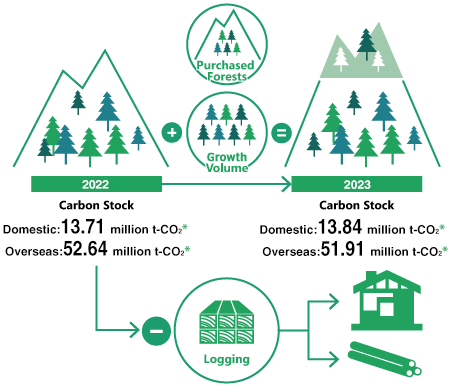
Logging and Usage
The Sumitomo Forestry Group logged approximately 168 hectares of trees in Japan and approximately7,289 hectares of trees overseas in fiscal 2024 in forests it owns or manages based on long-term logging plans. Harvested wood are milled and processed before finally reaching the market as products such as housing and furniture. In the case of wood turned into structural members for housing, the products are used for several decades. Even after being dismantled or at the end of their product life, wooden construction and timber and wood products can be reused as fiberboard or other wood materials in construction or as raw material for making paper, and all that time it will continue to retain CO2. The CO2 released when wood is ultimately burned as a wood fuel is what has been absorbed from the atmosphere as trees grow, and therefore it does not represent an increase in CO2 in the atmosphere over the life cycle of the tree.
- Click here for related information
Reforestation
Harvesting and using wood alone will lead to a diminishing of forest resources that will be used to produce wood products. The Sumitomo Forestry Group therefore promotes sustainable forest management by always planting new trees after logging.
In fiscal 2024, we planted forests on 75 hectares in Japan, and on 8,820 hectares overseas. The newly planted trees will absorb CO2 during their growth and retain it as carbon.
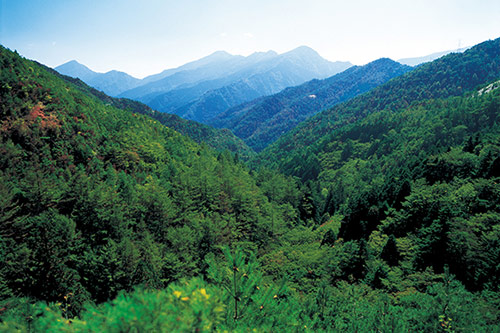
Company owned forests in Shikoku
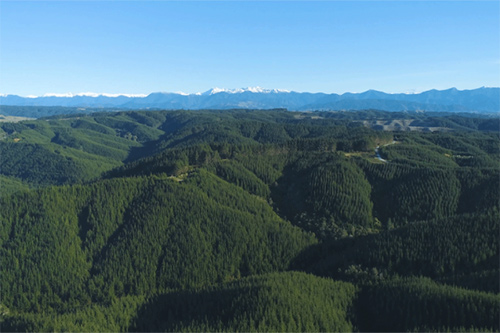
Planted forest in New Zealand

Planted forest in Papua New Guinea
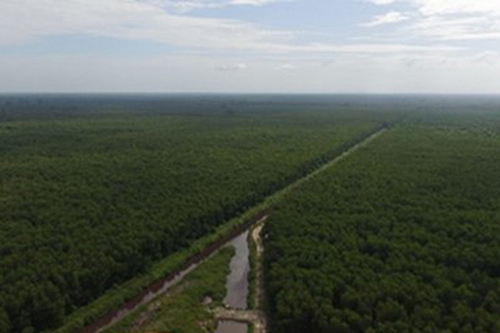
Planted forest in Indonesia
Area of Forest Managed and Owned by the Sumitomo Forestry Group
By Company: Company-Owned Forests and Overseas Plantations/Forest Management and Ownership Areas, etc.
| Japan | Managed Area (ha) |
Certified Area (ha) |
Production Forest Area (ha) |
Forest certification system*1 [Certification Number] |
Certification Issuing Body | Afforestation Area for Social Forestry*3 (ha) |
|
|---|---|---|---|---|---|---|---|
| Sumitomo Forestry | 48,050 | 47,962 | 27,472 | SGEC[JAFTA-010] | Japan Forest Technology Association (JAFTA) | 0 |
| Indonesia | Managed Area (ha) |
Certified Area (ha) |
Production Forest Area (ha) |
Forest certification system*1 [Certification Number] |
Certification Issuing Body | Afforestation Area for Social Forestry*3 (ha) |
|
|---|---|---|---|---|---|---|---|
| MTI | 104,664 | 74,870 | 10,534 | PHPL*2[015.4/EQC-PHPL/IX/2018] | PT Equality Indonesia | 0 | |
| WSL | 40,750 | 40,750 | 11,451 | PHPL*2[10-PHPL-006] | PT Almasentra Sertifikasi | 0 | |
| KMF | 9,270 | 9,270 | 5,688 | PHPL*2[IMS-SPHPL-009] | PT Inti Multima Sertifikasi | 0 | |
| BIOS | 9,738 | 0 | 0 | - | - | ||
| KTI | 5,505 | 0 | 5,505 | - | 7,283 | ||
| KAM KTI | 0 | 0 | 0 | - | 1,005*4 | ||
| KBM KTI | 0 | 0 | 0 | - | 1,330*5 | ||
| RPI | 52 | 0 | 49 | - | 417 | ||
| Total | 169,979 | 124,890 | 33,227 | - | 10,035 | ||
| Vietnam | Managed Area (ha) |
Certified Area (ha) |
Production Forest Area (ha) |
Forest certification system*1 [Certification Number] |
Certification Issuing Body | Afforestation Area for Social Forestry*3 (ha) |
|
|---|---|---|---|---|---|---|---|
| VECO | 0 | 0 | 0 | - | 1,151 | ||
| Papua New Guinea | Managed Area (ha) |
Certified Area (ha) |
Production Forest Area (ha) |
Forest certification system*1 [Certification Number] |
Certification Issuing Body | Afforestation Area for Social Forestry*3 (ha) |
|
|---|---|---|---|---|---|---|---|
| OBT | 31,260 | 12,993 | 11,618 | FSC®[NC-FM/COC-005600] | Preferred by Nature | 0 | |
| 6,792 | FSC®[NC-CW/FM-003093] | Preferred by Nature |
| New Zealand | Managed Area (ha) |
Certified Area (ha) |
Production Forest Area (ha) |
Forest certification system*1 [Certification Number] |
Certification Issuing Body | Afforestation Area for Social Forestry*3 (ha) |
|
|---|---|---|---|---|---|---|---|
| TPF | 35,695 | 35,313 | 25,211 | FSC®[SCS-FM/COC-400042] | SCS | 0 |
| Managed Area (ha) |
Certified Area (ha) |
Production Forest Area (ha) |
|
|---|---|---|---|
| Total | 284,984 | 227,950 | 97,528 |
*MTI: Mayankara Tanaman Industri, WSL: Wana Subur Lestari, KMF: Kubu Mulia Forestry, BIOS: Bina Ovippali Semesta, KTI: Kutai Timber Indonesia, KAM KTI: Koperasi Serba Usaha Alas Mandiri, KMB KTI: Koperasi Bromo Mandiri, RPI: Rimba Partikel Indonesia, VECO: Vina Eco Board, OBT: Papua New Guinea Open Bay Timber, TRF: Tasman Pine Forests
*1Forest Management (FM) certification authenticates sustainable forest management by having a third-party inspect based on objective indicators with focus on: (1) compliance with laws and system frameworks, (2) forest ecosystem and biodiversity maintenance and conservation, (3) respect for rights of indigenous people and local communities, (4) maintenance and enhancement of forest productivity
*2Pengelolaan Hvtan Produksi Lestari (PHPL) is an Indonesian certification of sustainable production forest maintenance
*3Area of planted forest was calculated using the actual number of seedlings distributed and the number of seedlings planted per hectare (The number of trees planted per hectare is planned annually for each tree species)
*4[Forest certification system] FSC® [Certification number] SA-FM/COC-002083 [Certification body] Soil Association
*5[Forest certification system] FSC® [Certification number] SA-FM/COC-005493 [Certification body] Soil Association
- Click here for related information
Managed Area of Forestry Fund
As of End of December, 2024
| Fund Name | Managed Area (ha) | Certified Area (ha) | Forest Certification Systems |
|---|---|---|---|
| Eastwood Climate Smart Forestry Fund I*1 | Approximately 80,000*2 | Approximately 47,000*2 | FSC, SFI, etc. |
*1Forest asset areas/United States, Canada, Panama, Costa Rica
*2Converted from acres
Other Managed Area
As of End of December, 2024
| Managed Area (ha) | Certified Area (ha) | Forest Certification Systems | |
|---|---|---|---|
| Japan Forest Asset Co., Ltd | 161 | 0 | - |
*Reference: Area of Planted Forests in Australia (as of February 2024): 957 hectares
- Home
- Sustainability
- Environment
- Sustainable Forest Management
- Sustainable Forest Management by the Sumitomo Forestry Group

